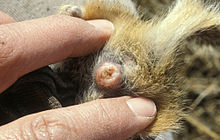- Mating plug
-
A mating plug, also known as a copulation plug, sperm plug, vaginal plug, or sphragis, is gelatinous secretion used in the mating of some species. It is deposited by a male into a female genital tract and later hardens into a plug or glues the tract together.[1] While females can expel the plugs, the male’s sperm still gets a time advantage in getting to the egg, which is often the deciding factor in fertilization.
The mating plug plays an important role in sperm competition and may serve as an alternative and more advantageous strategy to active mate guarding. In some species, such a passive mate guarding strategy may reduce selection on large male size.[2] Such a strategy may be advantageous because it would allow a male to increase reproductive success by spending more time pursuing new female mates rather than active mate-guarding.[2]
Contents
Composition
The mating plug of the Bombus terrestris was chemically analyzed and found to consist of palmitic acid, linoleic acid, oleic acid, stearic acid, and cycloprolylproline.[3] It was found that the acids (sans cycloprolylproline) were sufficient by themselves to create the plug. Researchers hypothesize that cycloprolylproline reduces female receptivity to further breeding.
Occurrence in nature
Mating plugs are used by many species, including several primates,[2] bees, rats, reptiles, squirrels,[4] scorpions,[5] mice,[6] and spiders.[7]
Use of a mating plug as a strategy for reproductive success can also be seen in a few taxa of Lepidoptera and other insects and is often associated with pupal mating.[8]
In homosexual matings
Male-male matings have been observed in species of acanthocephalan worms. Upon completion of the act, the penetrating partner will seal off the recipient's genital region with a mating plug.[9] Once sealed, the anal cavity becomes impervious to further infiltration.
See also
References
- ^ David Quammen. The Flight of the Iguana: A Sidelong View of Science and Nature. Simon and Schuster, 1998, ISBN 0-684-83626-2. Page 29.
- ^ a b c Dunham, A. E. & Rudolf, V. H. W. (2009). "Evolution of sexual size monomorphism: the influence of passive mate guarding". Journal of Evolutionary Biology 22 (7): 1376–1386. doi:10.1111/j.1420-9101.2009.01768.x. PMID 19486235.
- ^ Boris Baer, Roland Maile, Paul Schmid-Hempe, E. David Morgan, Graeme R. Jones. Chemistry of a Mating Plug in Bumblebees. Journal of Chemical Ecology, Volume 26, Number 8 / August, 2000. Pages 1869-1875
- ^ Vaginal plug. Biology online dictionary
- ^ Jorge Contreras-Garduño, Alfredo V. Peretti†, Alex Córdoba-Aguilar. Evidence that Mating Plug is Related to Null Female Mating Activity in the Scorpion Vaejovis punctatus. Ethology, Volume 112 Issue 2, Pages 152 - 163. 31 January 2006
- ^ Lars M Ittner & Jürgen Götz. Pronuclear injection for the production of transgenic mice. Figure 2 - Mating scheme and copulation plug. Nature Protocols 2, 1206 - 1215 (2007) Published online: 10 May 2007 doi:10.1038/nprot.2007.145
- ^ Knoflach, B. & van Harten, A. (2001). "Tidarren argo sp. nov (Araneae: Theridiidae) and its exceptional copulatory behaviour: emasculation, male palpal organ as a mating plug and sexual cannibalism". Journal of Zoology 254: 449–459. doi:10.1017/S0952836901000954. "no"
- ^ The encyclopedia of land invertebrate behaviour By Rod Preston-Mafham, Ken Preston-Mafham. Pg 113.
- ^ Lawrence G. Abele, Sandra Gilchrist. Homosexual Rape and Sexual Selection in Acanthocephalan Worms. Science, volume 197, issue: 4298, pages 81-83. 1977
Categories:- Reproduction
- Animal sexuality
- Mating
- Biology stubs
Wikimedia Foundation. 2010.


